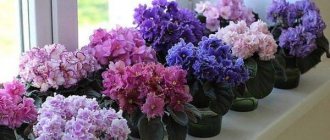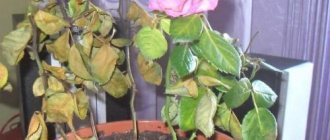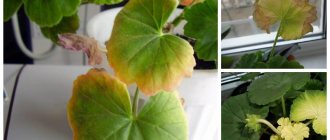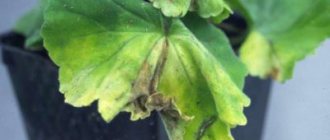Excess fertilizer
Potted flowers are grown in industrial conditions. Plants are overfed with various chemicals. Here is a list of the main macro- and microelements, an excess of which has a negative effect on the flower.
Nitrogen
There is a sharp jump in growth activity, with the formation of an abundant number of short and long shoots. Leaf blades densely cover the plant. Greens and juicy buds attract pests and fungus.
Potassium
Lightened areas are noticeable on the foliage. Leaf blades located next to the soil acquire a gray or gray-green tint. The plant does not develop and dies.
Phosphorus
The leaves become deformed and turn yellow. There is a weakening of growth activity.
Calcium
The foliage tissue dies, and then the root system withers.
This problem can be solved if, after purchasing the flower, the flower is transplanted into another soil. At the transplanting stage, the roots are thoroughly but carefully washed.
Superstitions and signs about indoor flowers - ensuring our comfort
Superstitions and signs about indoor flowers will tell you how to improve your life with the help of properly selected plants and which varieties should be avoided when placing them in the house.
Superstitions and signs about indoor flowers
It is believed that a house where indoor plants die is filled with negative energy. This is wrong. Most plants, when you take good care of them and devote a considerable part of your time, are able to ward off diseases and negative programs from their owners.
When one plant withers, it means that it has warded off a strong evil eye, damage or serious illness. But this does not mean that there is negative energy in the house. Thank the dead flower, and then bury it on the street or in the area.
House flowers dry up one after another - either there is a presence of strong negativity in the house, or serious damage. But when it's not about care. Some plants are whimsical, and some of them react to loud sounds. A good explanation for the sign that says: flowers do not take root in a house where scandals are a frequent occurrence.
Flowers get sick and wither for natural reasons. This portends purchases.
With their help, the negative zones of the apartment are determined. When a plant that was growing well before the “move” begins to fade, for example, near the bed, then move the latter to another place.
When a plant blooms in the middle of winter and is covered with inflorescences in the summer, it’s a surprise. In certain regions of Russia and other countries - to death in the house. The interpretation also depends on the properties of the plant. Unexpected flowering of the money tree means the unexpected appearance of money.
It is believed that it is impossible to give plants in pots; this transfers the failures and problems of the giver to the person for whom the gift is intended. When you receive one, give a coin of any denomination in return. So the plant will think that it was bought and has received a new owner, and it does not need the energy of the old one.
Good signs about indoor plants
There are plants that carry positive energy and are suitable for everyone.
Crassula, or Crassula, attracts the energy of money into the house. With proper care and conditions for growth, it will help you get rich. Choose a pot for it red or green - the colors of money magic. Place coins in it when planting Crassula. The fern protects against harmful radiation from electrical appliances, so place it near the TV or computer. This property allows them to replace the usual cacti; negative signs are associated with them.
Another name for spathiphyllum is women's happiness. This plant carries one positive energy - it brings family happiness and prosperity. You can read more about the meaning of spathiphyllum in a separate article on the website.
Bamboo carries the energy of career growth, the desire for success and good luck in business and at work. But it brings happiness when a pot with a plant is placed on the desktop. In the bedroom, near the bed, such aspirations are useless.
Aloe serves as a normalizer for family relationships and communication with guests, and brings peace and tranquility to the home. This plant will protect against unwanted visitors and their influence. Therefore, they are placed near the entrance to the room.
Breed sour wood when you have problems finding a suitable partner or in a relationship with the existing one. It normalizes family and love relationships.
Hibiscus is a flower of love and passion. Perfect for newlyweds and older couples. Helps in strengthening and restoring normal family relationships. Avocado has a similar meaning.
Tradescantia protects the owner from gossip, and aspidistra adds strength to character.
Ficus is a plant that gave Adam and Eve leaves to hide their nakedness and fruits (figs are a type of ficus) to satisfy hunger. It is considered the patron of the hearth and home, bringing prosperity and good luck. Read about the signs about ficus trees.
Chlorophytum purifies the air and, according to signs, brings happiness to family members.
Violet helps resolve conflicts peacefully. When there are scandals in the house, plant violets. Find out about the signs about violets.
Geranium fights stress, loneliness and depression, and also boosts confidence. It makes a person’s character calm and balanced.
Dracaena improves mood, shares energy, brings good luck and success.
All citrus plants are favorable for placement in the home. They bring good luck, happiness, wealth and love.
House roses symbolize fidelity and chastity. When you are worried about your teenage daughter, place a box of roses, preferably white ones, in her room. In the matrimonial bedroom, marriage is protected from betrayal and deception.
Bad pot
Store-bought flowers grow in planting containers. They are then transported in paper. After arriving at the flower stall, the plants are placed in pots. Unscrupulous sellers plant the flower in a new pot without removing the packaging. The roots stop developing and the plant dies.
Store pots are “temporary homes” for plants. They are not suitable for normal cultivation. Small containers are too cramped for the root system, and large ones speed up the rotting process.
Poor soil
The majority of manufacturers are trying to save money. Flowers do not receive quality nutrition from the soil. Very often, plants are grown in sand, peat, and transported in perlite, vermiculite, coconut fiber, and plain paper. Infertile soil is watered abundantly or dried out.
If the soil is too dry, the plant will die. Overwatering promotes the formation of mold in the root system. The roots of the flower gradually die off during delivery to the store, and if planted incorrectly in a pot, they die. A customer brings home a dead plant.
Sometimes in greenhouses the soil is not replaced with new soil. A new batch of flowers is grown in the same soil. Gradually it is depleted, loses all nutritional properties, and becomes useless.
Some tips for preserving cut flowers
It is necessary to follow the rules for caring for any cut flowers, be it roses, chrysanthemums, lilies, carnations, asters. The bouquet will please longer if:
- prepare a container of water before cutting;
- store the bouquet at the appropriate temperature;
- process freshly cut flowers;
- provide care for the bouquet standing in the vase.
Vase for a bouquet of flowers
The vase must be washed thoroughly before placing the bouquet in it.
The presence of microbes that will reach the flowers along with water will accelerate the death of plants. Wash the vase with any detergent, then rinse with cool water.
Temperature
It is necessary to protect flowers from sudden temperature changes. When taking a bouquet from a warm room into the cold, be careful and, if possible, use a packaging bag. Some types of flowers, being at a temperature of -5°C for several minutes (no more than 10), may die. If you bring flowers from frost into a warm room, this also causes great harm to the plants. Don’t put them in a vase right away, let them gradually get used to the next temperature change. After 15-20 minutes, lower the bouquet into a pre-prepared vase with cold water.
Rules for caring for cut flowers
Processing of cut flowers
It is necessary to remove the leaves from the flower stem. Then place the bouquet under running warm water and make cuts at a 50° angle with a sharp knife. After this procedure, the plant will better absorb moisture.
Flowers with hard stems should be doused with hot water: the oils contained in the stem of the plant will close the lumen of the blood vessels, so that bacteria will not penetrate inside the plants. Such flowers include, for example, jasmine.
Caring for a bouquet in a vase
The water in the vase containing the flowers should be changed every day. Stale water is not able to prolong the life of plants, and they will quickly begin to wither. Also wash the vase before each water change.
It would be a good idea to spray the bouquet daily with a spray bottle.
Improper care in the store
The negligence of the seller is another reason why the flower quickly dies. Improper care consists of the following nuances:
- damage to roots during transplantation;
- abundant watering;
- cutting buds and leaves, which are important for further growth;
- dampness;
- not careful loosening;
- feeding with unknown substances.
Typically, sellers rely on a quick sale of indoor plants and do not pay due attention to them. Therefore, the buyer purchases a diseased or lifeless plant.
Improper care after purchase
Flower growers, especially beginners, neglect the advice of sellers and specialists. The Internet is filled with “miracle recipes” that promise dense vegetation for several years. It is a mistake to trust such advice, much less use it in practice.
There are many ways to help a flower from a store find lush greenery and beautiful buds. They consist of the following actions:
- After purchase, the plant is transplanted into a more suitable pot. The dimensions of the pots must correspond to the height of the stem and the width of the leaf blade;
- The roots are carefully washed and the flower is placed in fertile soil. The soil is selected based on the type of plant. If you do not change the industrial soil to soil rich in nutrients, then earthworms and pomurs will appear in the pot;
- eliminate the impact of drafts, dampness, and high temperatures on the sprout;
- apply preventative measures in pest control. It is enough to bathe the plant in the shower once a week.
If the florist does not have experience in growing indoor flowers, then you can consult with more knowledgeable people. Often among friends there are lovers of ornamental plants who have a full-fledged garden in their home or country house.
If the flowers begin to fade
If the flowers have wilted a little, you can cover them with damp paper or plastic wrap. Then immerse in warm water (no more than 40°C). The plants will be filled with moisture and take on a blooming appearance.
Some types of flowers, such as lilacs or roses, can be literally brought to life by cutting off the very ends of the stems and soaking the plants in very hot water for 10 minutes.
Another way to revive flowers is to use bleach . You need to add a few drops of the substance to the vase. This method will be effective only at the first signs of wilting of the bouquet.
What to do if the flowers have already begun to fade?
It is possible to extend the life of flowers if you follow simple rules for processing cut flowers and care for them in a vase every day.
the video presented will also help you extend the life of flowers :
Pests and diseases
Flowers attract various pests. Like other living organisms, a plant can suddenly become ill. Here are a few ailments that are considered the most common.
Powdery mildew
The reasons are high humidity and attacks by insects and mites. Symptoms are the formation of a dense white coating on the leaves and stems. The plaque contains fungal spores. The disease is treated with special fungicides.
Sticky leaves
Reasons: scale insects, false scale insects, aphids, mites or whiteflies have settled. Symptoms - leaves on the hands leave sticky marks - waste products of pests. It is recommended to treat the plant with insecticides and acaricides.
Dry leaf tips
Reasons: watering with hard water, excessive moisture or drying out of the soil, improper fertilizing, high room temperature, cramped pot. Additionally, the plant is inspected for the presence of pests. The type of treatment is selected taking into account the cause of the appearance of dry yellow leaves.
The most dangerous pests are: aphids, mites, whiteflies, weevils, cicadas, caterpillars, scale insects, red spider mites, woodlice, centipedes and miner flies. Chemicals for killing insects are sold in hardware stores. The best way to treat a plant is to prevent the appearance and reproduction of insects.
To ensure that the purchased flower remains strong, healthy and beautiful, it is enough to follow simple preventive measures. Moderate watering and timely fertilization, maintaining a comfortable temperature in the room, regular pruning and replanting are the main requirements aimed at the favorable development of the flower.











